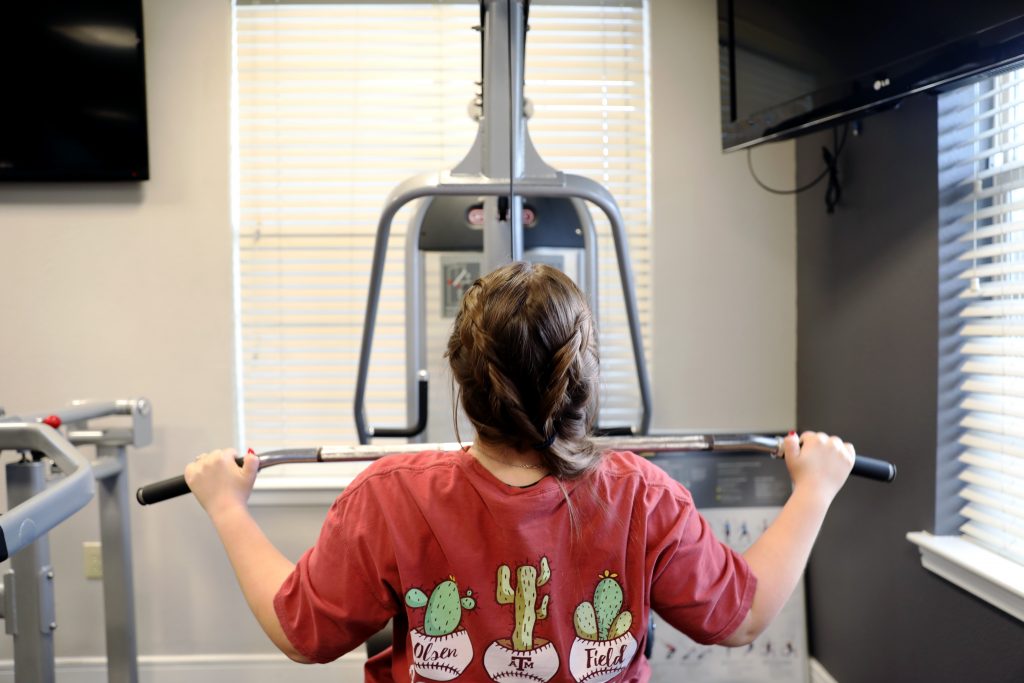Physical Exercise As A Mood Booster
Feeling down? Move your body! Sports psychology professor explains why exercise improves mood and offers advice on how to make exercising work for you.

By Brittney Nava ‘23
Photos by Anna Burson ’24
 Slamming heavy weights, tracking macros, mixing pre-workout — these intense components of modern gym culture can make daily exercise feel like a cutthroat sport; however, a beneficial exercise regimen doesn’t have to focus solely on physical gain.
Slamming heavy weights, tracking macros, mixing pre-workout — these intense components of modern gym culture can make daily exercise feel like a cutthroat sport; however, a beneficial exercise regimen doesn’t have to focus solely on physical gain.
Beyond growing muscle mass and improving physical health, evidence also shows that exercise positively impacts mood.
While the relationship between exercise and mood improvement is quite complex, sports psychology professor Arnold LeUnes pointed to four theories that seek to explain the positive correlation: The distraction hypothesis, the endorphin hypothesis, the monoamine hypothesis, and the thermogenic hypothesis.
According to LeUnes, the distraction hypothesis says that exercise simply serves as a distraction from everyday stresses, allowing an individual to step out of their worries and into the present moment.
While the distraction hypothesis provides a psychological explanation for exercise related mood improvements, the endorphin, monoamine, and thermogenic hypotheses look more closely at physiological processes.
“There’s the endorphin hypothesis, of course, and everybody’s heard about brain endorphins,” LeUnes said. “They are released when we engage in exercise, and produce a positive mood state.”
Endorphins are neurotransmitters that can help reduce feelings of pain and boost your mood, but they aren’t the only neurotransmitters increased during and after exercise.
“The monoamine hypothesis has to do with brain chemicals called the monoamines,” LeUnes said.
Monoamines are neurotransmitters such as serotonin, dopamine, and norepinephrine. They have a wide range of functions in human physiology, one of which affects mood states. Individuals with clinical depression are observed to have depleted levels of monoamines, and are sometimes prescribed monoamine oxidase inhibitors, a class of antidepressant drugs that increases monoamines in the brain.
“The monoamine theory suggests that exercise does the same thing these antidepressant drugs do, that it affects the regulation of these brain chemicals and produces a positive mood,” LeUnes explained.
Lastly, the thermogenic hypothesis looks at increases in body temperature as a cause for improved mood.
“Some people feel that this is the real virtue of exercise — that body temperature escalation produces a calming effect,” LeUnes said. “However, there have been studies done comparing running with yoga. Both seem to have a positive effect on depression, yet they are two very different kinds of things in terms of physical demand.”
Whether it’s the result of a shift in brain chemistry, a change in our core temperature, or simply a distraction, exercise is one way that we can all show a little love to our mental health.
 How to get started and keep at it
How to get started and keep at it
While maintaining a rigorous gym routine may be necessary to achieve high fitness goals, that’s not the case for achieving an elevated mood state. Oftentimes, increased mood states occur immediately after exercise, however, in order to see long term effects on mood, there does need to be a level of consistency.
“Most fitness recommendations would have you doing a combination of jogging and weight work, three to five days a week,” LeUnes said. “But it’s absolutely critical that you choose something that fits you. I wouldn’t recommend jogging for everybody. People vary greatly in their ability to tolerate the pounding that goes with jogging.”
Rather than thinking of exercise in terms of weightlifting and running, breaking it down into muscle work and aerobic exercise can help broaden the scope of possible activities. For example, muscle work can include body weight exercises and aerobic exercise can be dancing or swimming.
“‘No pain, no gain’ is a bad fitness philosophy,” LeUnes shared. “It doesn’t have to be painful to do some good. You don’t have to constantly step it up to another level. Find the level you’re comfortable with and just go with it.”
According to LeUnes, reinforcing your exercise routine is key to maintaining consistency.
He pointed to social reinforcement as an effective method. This may be joining a fitness class, finding a gym partner, or even engaging in online fitness groups.
“Keep it balanced and keep it fun,” LeUnes advised. “Find something that fits you, something that you can really enjoy and that you can reinforce.”
